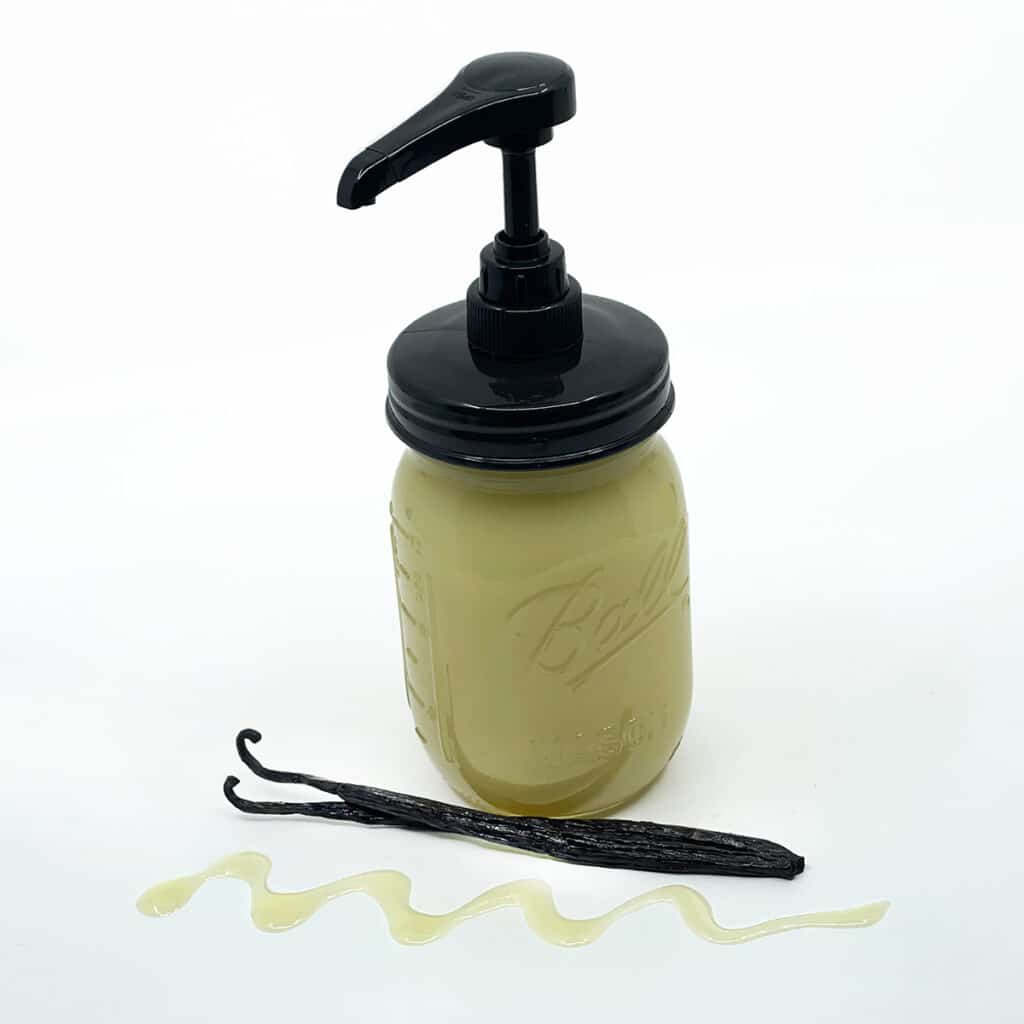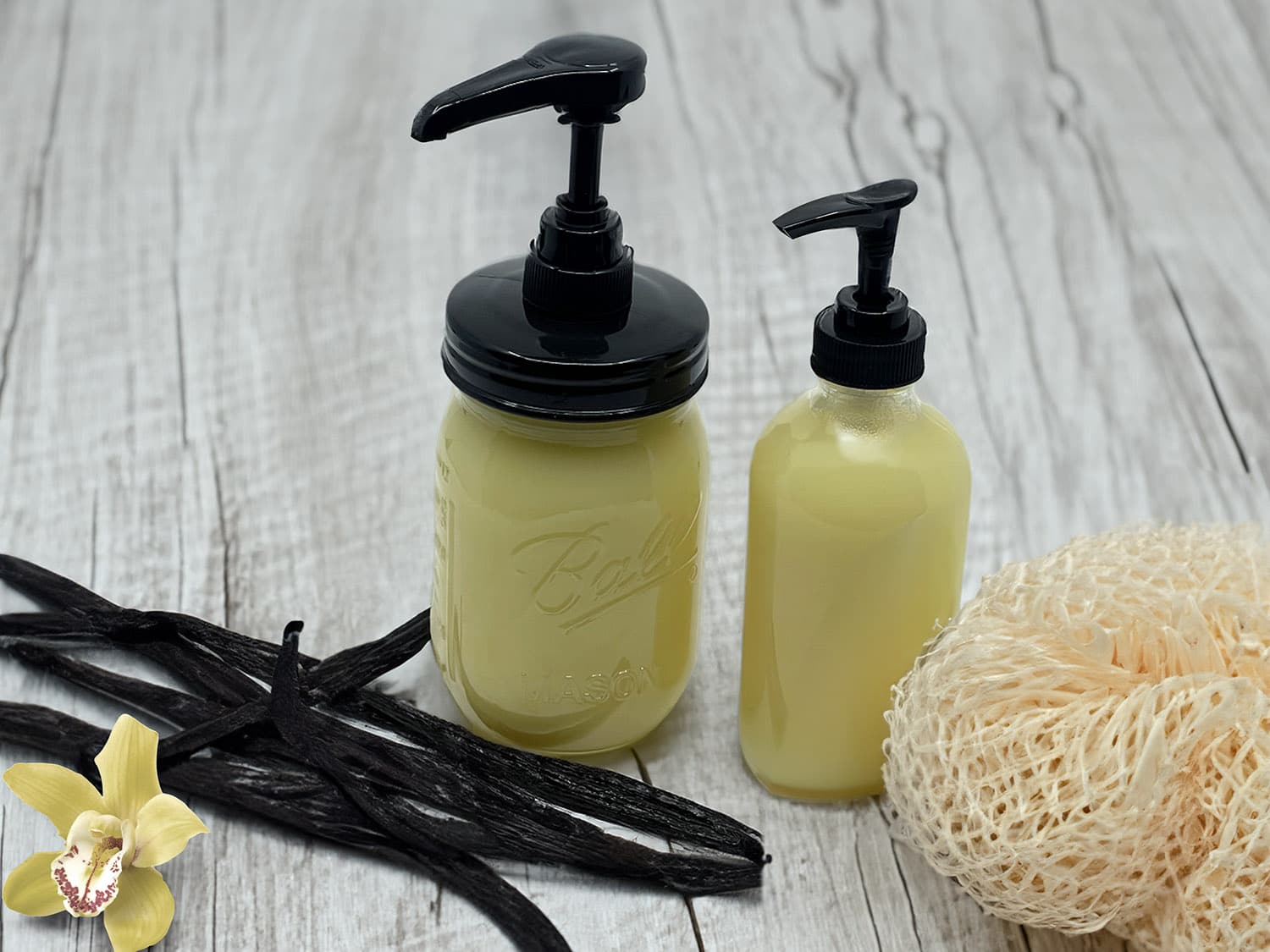I don’t know why it took me so long to think of trying this, but OMG y’all, I think I’m in love.
My “skin twin” sebum mimicking oil trio makes a killer shower oil with a lovely “creamy” texture. The tallow thickens and gives a bit of body to the lighter jojoba and squalane oils and the result is a lovely creamy oil blend that resembles a cross between a lotion and an oil and is thick enough to dispense nicely from a pump bottle.
But why would you want a big bottle o’ oil in the shower?
Oil as a cleanser
For close to 25 years now, I’ve followed the advice to wash only certain parts of the body with soap. I like to call it “pits & bits.” A friend’s very proper British mother refers to it as “tops & tails.”
Whatever you call it, the basic idea is that by focusing on cleansing the areas that accumulate the most dirt, sweat and odor — e.g. the underarms, groin and bottoms of the feet — we can maintain cleanliness while preserving our skin’s natural surface oils that protect and nourish the rest of the body.
Our skin has a slightly acidic pH, which helps to keep it healthy and defend against harmful bacteria or pathogens. Frequent washing with soap can disrupt this natural pH balance and compromise the skin’s protective barrier.
Those of you who have tried the oil cleansing method will be familiar with the basic principle that “like dissolves like.” Oil effectively dissolves and lifts away oil-soluble environmental pollutants, excess sebum and other gunk. And perhaps counterintuitively, cleansing with oil instead of soap can actually be beneficial for those with oily or congested skin, since you’re not constantly stripping the skin of its protective oils and forcing it into overproduction to compensate!
Oil as a protectant
Okay, so we all know that overly-hot showers (sadly) aren’t great for our skin. Like soap, hot water strips away those natural oils and moisture that we’re trying to hang onto, leaving our skin feeling dry and tight. But sometimes, a nice hot shower is just too good to resist. There’s nothing I want more after shoveling snow or after a long snowshoe hike!
Applying oil before a shower may seem counterintuitive if it’s just going to get rinsed off again, but thanks to oil’s natural occlusive properties, a pre-shower oil can help mitigate the damaging effects of the hot water and create a protective barrier that helps prevent the hot water from stripping away your skin’s natural oils.
I’d still reserve extra-hot showers for the occasional treat, but thanks to our protective shower oil, the odd post-freezing-outdoor-activity hot shower is back on the menu!
Oil as a moisturizer
Oils by themselves don’t make the best moisturizers for one simple reason: The skin needs both oil and water to be adequately hydrated. While applying oil to dry skin can temporarily smooth and improve its appearance, it does not address the underlying issues of dryness and insufficient hydration.
As a skincare ingredient, oil primarily acts as an occlusive, forming a barrier on the surface of the skin to hold in moisture and prevent further water loss. It also has emollient properties, which soften, soothe and smooth the skin’s surface. Sounds great, right? But there’s a very important missing element: water. Oil can’t provide additional moisture or hydration on its own. Dry skin by definition lacks proper hydration, and without water, the oil barrier can only trap whatever limited moisture is already present in the skin.
In order to adequately moisturize dry skin, a humectant is needed to attract and bind moisture from the environment to the skin, increasing its water content. Water is a humectant, which is why emulsified lotions — a combination of oil and water bound together with an emulsifier — were created. They contain a balance of both oil and water, providing comprehensive hydration to dry skin. The water replenishes the lost moisture and the oil seals it in. A match made in heaven!
So without the built-in water content found in lotions, you’ll need to introduce water some other way. The absolute BEST time to apply oil to your skin is when you’re still damp from a warm shower, sealing in all that lovely water and preventing dryness long after you’ve dried off from the shower.
You’re left with skin that doesn’t just feel hydrated — it’s actually hydrated!
Damp skin also absorbs products more effectively than dry skin, so when you apply an oil immediately after showering, the oil can penetrate the skin more easily, allowing it to deliver its moisturizing and nourishing properties to the deeper layers of skin. This ensures maximum absorption and effectiveness of the oil (as well as any other herbs and cosmeceuticals you may have added to the oil blend).
Heavenly vanilla
I just love vanilla. It’s probably one of my top three favorite scents! Though Vanilla planifolia is not extensively used in Western herbalism as a medicinal herb, it’s often used in aromatherapy for its rich, sweet and comforting fragrance, which is believed to have mood-enhancing, stress-reducing and anxiety-relieving properties.
The scent of vanilla certainly works to make me happy!
The most prominent fragrant constituents in vanilla beans is vanillin and its derivative vanillic acid, which are responsible for vanilla’s sweet, complex and distinctly “vanilla-y” aroma and flavor.
Vanillin is a somewhat lipophilic (fat-soluble) phenolic aldehyde that will dissolve in oil. Vanillic acid is a phenolic compound also has some degree of solubility in oil, though alcohol is a better solvent in both cases.
We can maximize the extraction of these aromatic compounds by doing an alcohol intermediary oil infusion. Alcohol is a more efficient solvent for certain aromatic compounds, and it can help break down cell walls in plant material, aiding in the extraction process.
I just *barely* covered my chopped vanilla beans with a splash of 190-proof neutral grain alcohol and let them sit overnight before adding them to the crockpot:
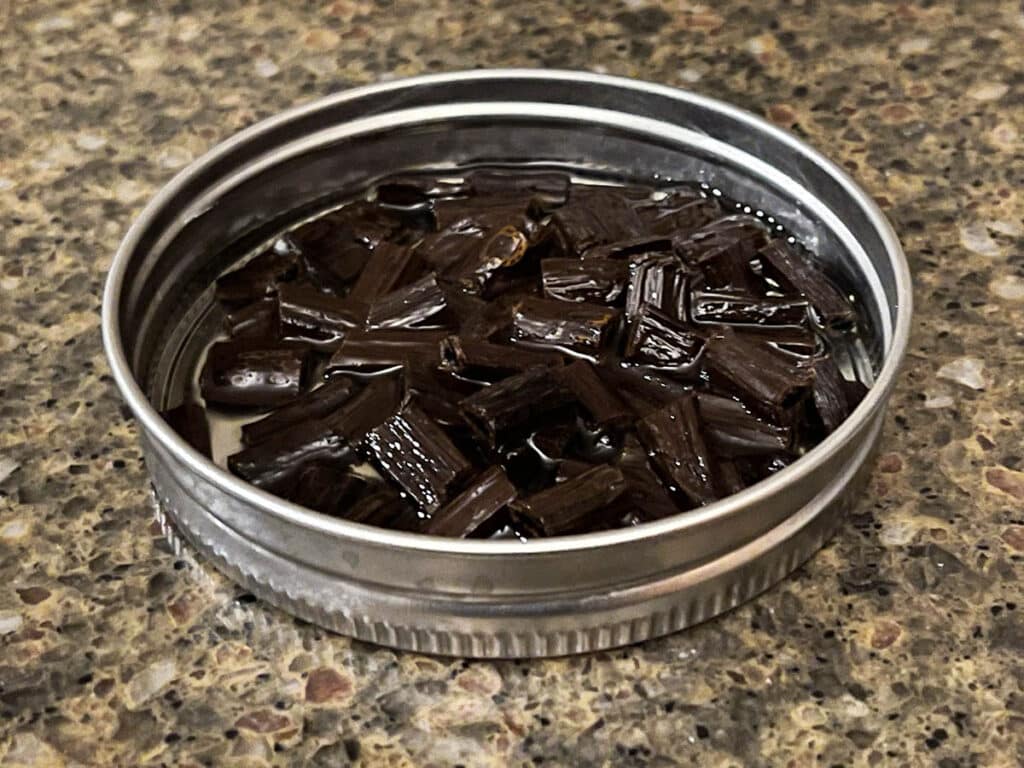
Grading vanilla beans
Vanilla beans are typically sold as either “grade A” or “grade B” based on their quality and appearance. Grade A beans are typically larger, plumper, and more visually appealing than B grade. They usually also contain a higher percentage of vanillin.
For this purpose, I would recommend going with the less expensive B-grade beans. We really don’t care what they look like and the cost savings is significant enough that we can always use a few more beans to offset the lower amounts of vanillin.
Subtle, but lovely
I used about 15 ounces (by weight) of tallow, 10 ounces of jojoba and 5 ounces of squalane, plus five B-grade vanilla beans. This made roughly 1 quart of vanilla-infused shower oil.
I held my oils and vanilla beans in a mini crockpot (modified with a dimmer switch) at approximately 100F for five days, attempting to extract as much out of my 5 precious vanilla beans as possible.
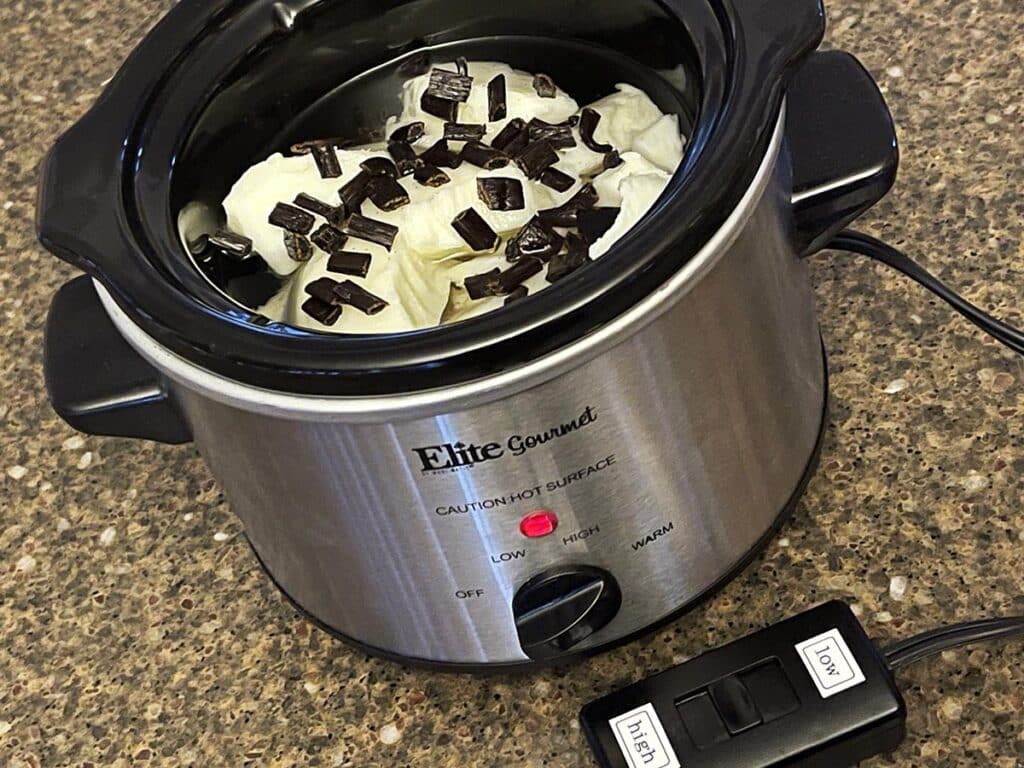
The end result was a lovely but subtle vanilla aroma. You may get a stronger fragrance by using more beans, but it’s not terribly cost effective. Even B-grade vanilla beans can get pricy, which is why I capped this experiment at 5 beans to about a quart of oil.
You can always enhance the scent with essential oil. Real vanilla absolute is amazing, but cost prohibitive. Benzoin resin (Styrax tonkinensis) is an inexpensive alternative that smells remarkably like vanilla. CO2-extracted coconut oil (Cocos nucifera) is another lovely and inexpensive option.
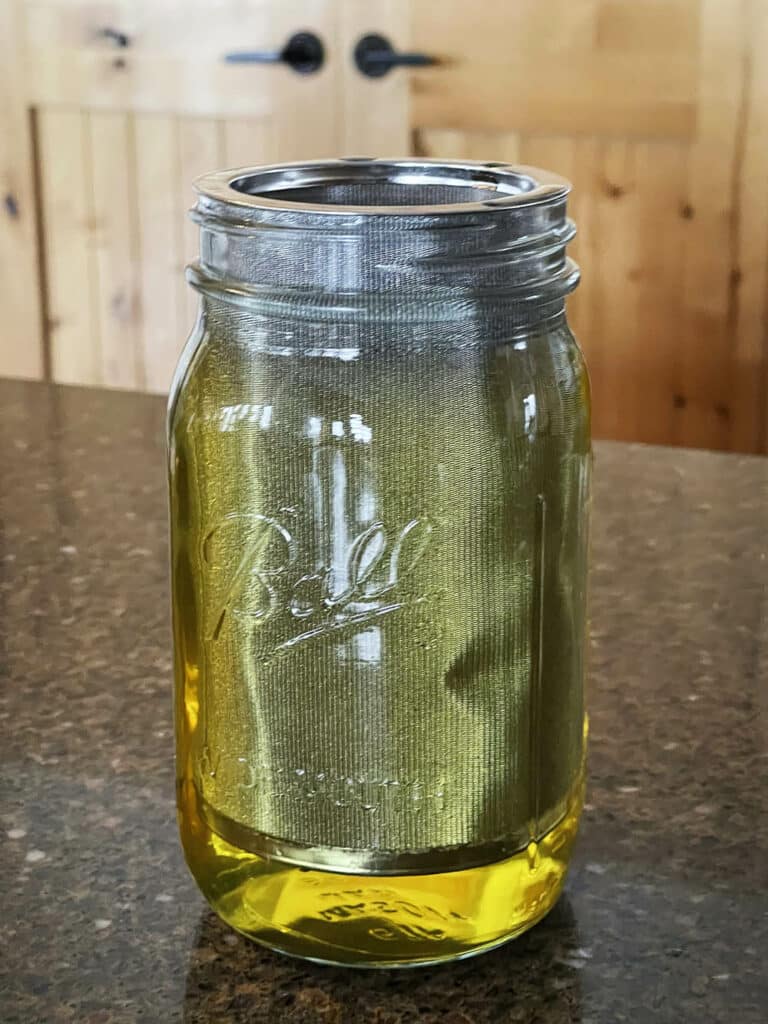
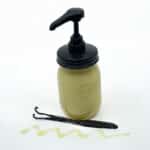
Creamy Vanilla Bean After-Shower Skin Serum
5 Stars 4 Stars 3 Stars 2 Stars 1 Star
No reviews
Ingredients
3 parts tallow (by weight)
2 parts jojoba oil (by weight)
1 part squalane (by weight)
B-grade vanilla beans, split and chopped
Instructions
- Using a kitchen scale, measure your oils into a glass mason jar or the ceramic crock of a mini slow cooker.
- Gently heat tallow until it’s completely melted and liquid.
- Stir in jojoba, squalane oils and split/chopped vanilla beans.
- Allow to infuse at approx. 100F for 4 or 5 days or until the oils have taken on the fragrance of the vanilla beans.
- Using a very fine mesh strainer or nutmilk bag, strain out the vanilla beans and discard.
- Pour oil into a glass pump bottle and allow to cool completely before adding the pump. It will thicken a bit as it cools.
- To use, apply a small amount to wet/damp skin immediately after bathing. Also useful as a skin protectant before a hot shower.
Notes
Want a shimmery after-shower oil? Add a smidge (and I do mean a smidge — a little goes a long way) of pearl or bronze mica to your oil!
The downside to oiling up in the shower is it *can* make the tub/shower slippery. If you don’t have an anti-slip shower mat or tub decals, simply stand on an old towel while you shower to prevent a slippy accident.
